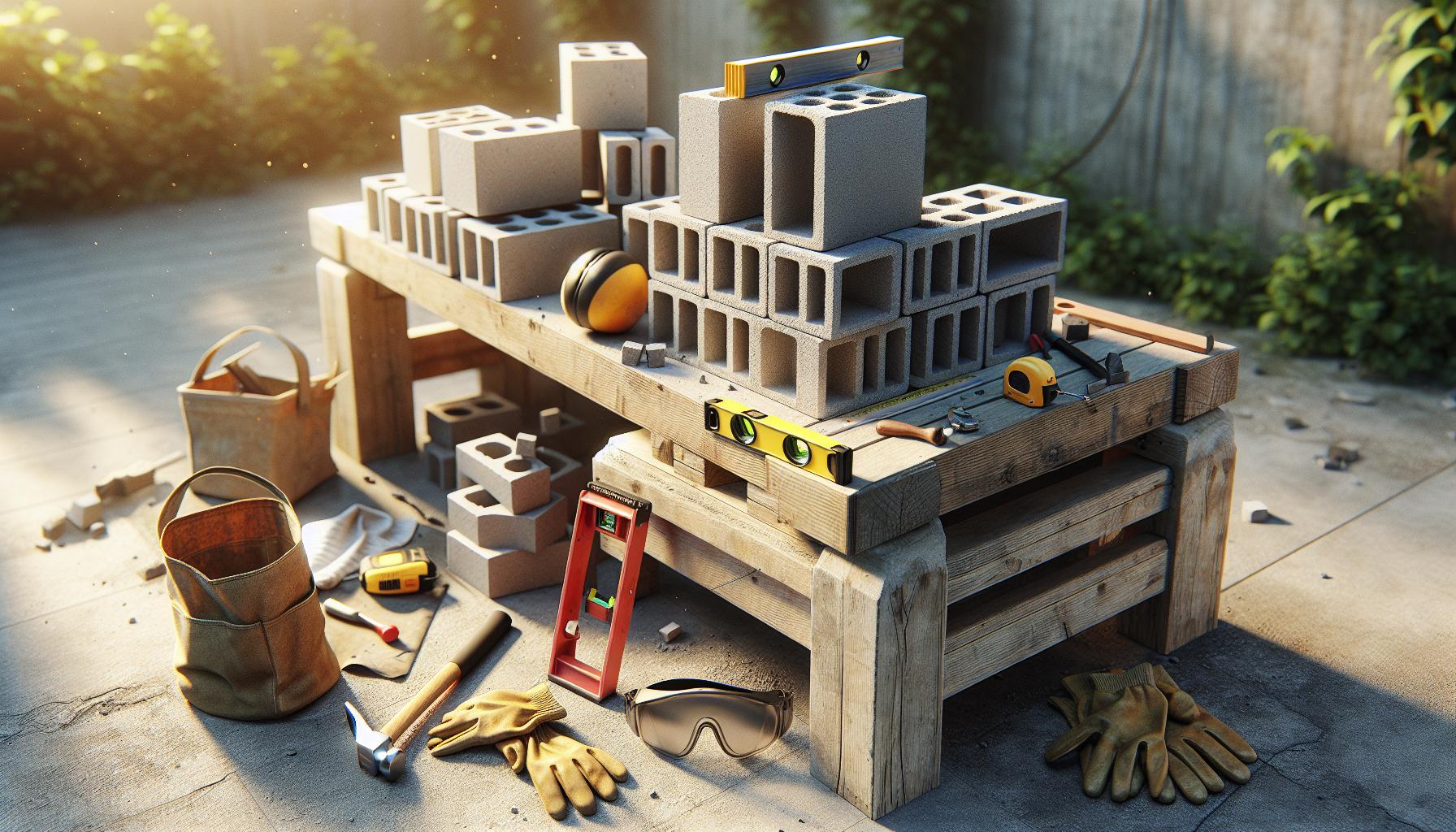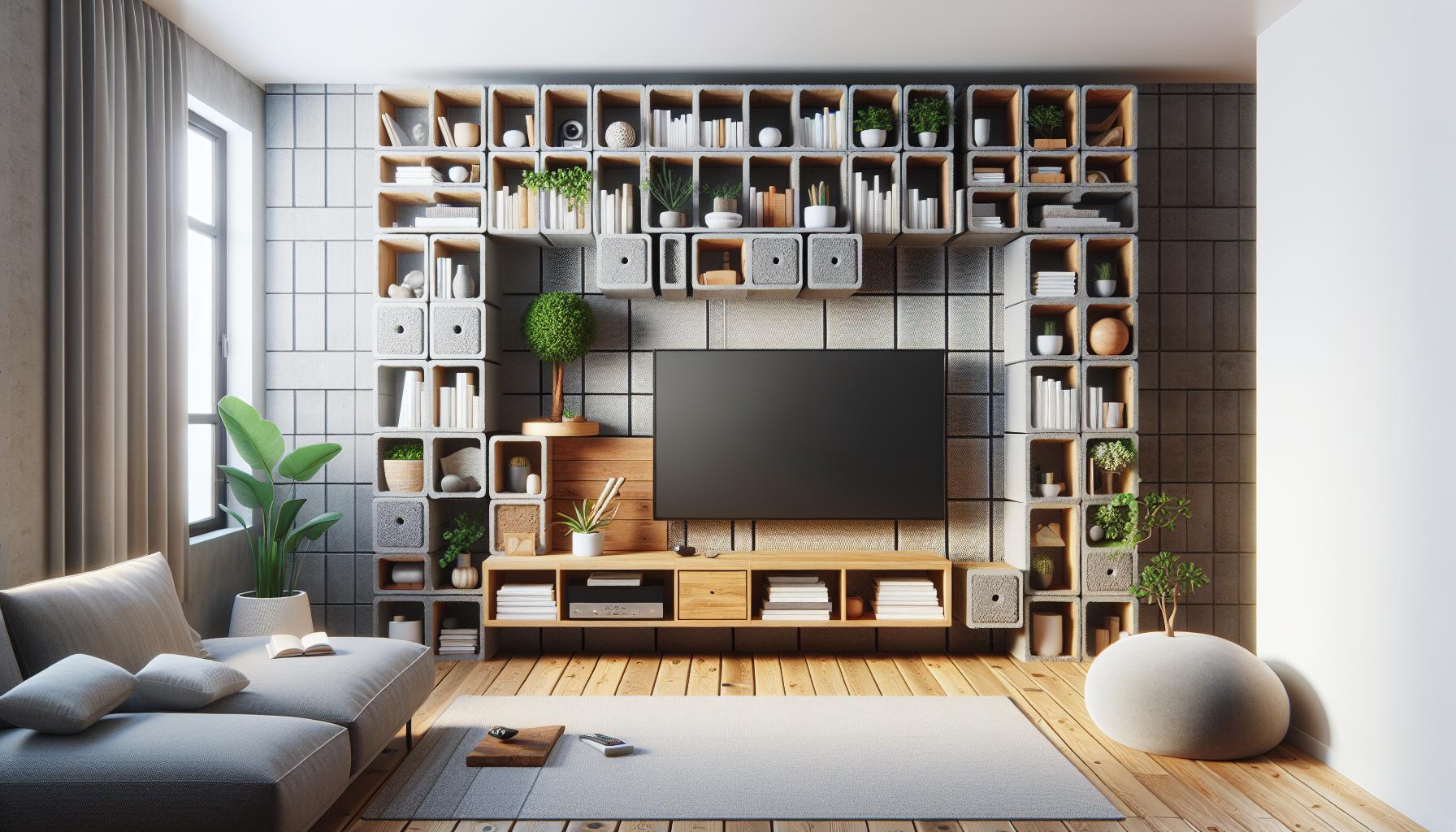When it comes to DIY projects, cinder blocks are the unsung heroes of versatility and creativity. These sturdy, affordable building materials are often overlooked, yet they hold endless potential for transforming spaces both indoors and out. Whether you’re a seasoned DIY enthusiast or just starting out, cinder blocks offer a simple way to bring your design dreams to life without breaking the bank.
I’ve always been fascinated by the endless possibilities cinder blocks present. From creating stylish outdoor furniture to crafting unique planters, these blocks are perfect for adding a touch of industrial chic to any setting. Their durability and ease of use make them ideal for quick projects that don’t require a professional touch. Dive into the world of cinder block DIY projects with me, and let’s explore how these humble blocks can elevate your home and garden in unexpected ways.
Key Takeaways
- Versatility of Cinder Blocks: Cinder blocks are highly versatile, making them ideal for a variety of DIY projects, from indoor shelves to outdoor furniture and planters, blending style with functionality.
- Cost-Effective Solutions: They offer an affordable alternative to traditional building materials, enabling large-scale and robust projects without incurring significant costs.
- Durability and Outdoor Use: Their durable nature is perfect for outdoor applications, capable of withstanding the elements, which is ideal for constructing items like garden benches and fire pits.
- Creative Personalization: Painting, stacking, and pairing with other materials allow for personalized and aesthetically pleasing designs, enhancing the visual appeal of any space.
- Safety and Practicality: Proper handling with safety gear is crucial due to their weight and shape, ensuring projects are completed securely and effectively.
- Maintenance and Longevity: Regular maintenance, waterproofing, and structural reinforcement are essential for prolonging the life and ensuring the stability of cinder block projects.
Cinder Block DIY Projects
Cinder block DIY projects blocks offer a vast range of possibilities for creative DIY projects. Their versatility stems from their simple yet functional design, characterized by hollow centers and a sturdy concrete composition. These features make cinder blocks ideal for projects that demand both structure and style. With the right tools and a bit of imagination, I can transform cinder blocks into practical and aesthetically pleasing objects.
The durability of cinder blocks allows them to withstand outdoor elements, which is perfect for exterior applications. For example, using cinder blocks as a garden bench or retaining wall adds both function and visual interest to outdoor spaces. It’s possible to stack them in various configurations, allowing for customization in project designs and accommodating different spatial requirements.
Affordability is another significant advantage of using cinder blocks in DIY projects. They are a cost-effective material compared to other building options, enabling me to execute large-scale projects without breaking the bank. Whether I’m creating planters or constructing shelves, cinder blocks provide sturdy support at a fraction of the cost of traditional building materials.
Safety considerations are crucial when working with cinder blocks. Their weight and shape necessitate proper handling to prevent injury. When stacking or cutting blocks, I find it essential to use appropriate protective gear like gloves and safety goggles. Additionally, securing blocks with mortar or adhesive can ensure stability and safety in completed projects.
Creativity is limitless when it comes to utilizing cinder blocks in unique ways. By painting, stacking, or integrating them with other materials, I can achieve personalized designs that reflect my style. Whether it’s crafting a modern fire pit or a minimalist table, cinder blocks offer both a blank canvas and a sturdy framework for various DIY endeavors.
Essential Materials and Tools

Cinder block DIY projects require the right materials and tools for success. Ensuring proper selection simplifies the process and enhances creativity.
Selecting the Right Cinder Blocks
Choosing quality cinder blocks is crucial. Select blocks with uniform dimensions to ensure stability and aesthetics in the project. Consider the block type based on the project’s requirements. For retaining walls or structural elements, heavier blocks add strength. For garden planters or decorative features, standard-sized blocks work well. Purchase blocks that have consistent color and texture to achieve a seamless look.
Gathering Handy Tools
Assembling a reliable set of tools streamlines the construction process. Start with a sturdy wheelbarrow or dolly for transporting heavy cinder blocks safely. A rubber mallet aids precise placement and adjustments. Use a spirit level to ensure each row of blocks remains even. Add safety goggles and gloves to protect yourself from dust and abrasions during handling. For projects involving adhesive or mortar, have a trowel and mixing bucket ready. Finally, include a tape measure for accurate placement and spacing.
Creative Home and Garden Ideas

Cinder blocks present endless opportunities for enhancing both homes and gardens. Their durable nature supports a variety of creative projects that elevate outdoor aesthetics.
Cinder Block Planters
Creating cinder block planters is an excellent way to introduce green spaces in your garden. The hollow centers of cinder blocks are perfect for planting herbs or succulents. I arrange them on patios or along pathways, maximizing space vertically by stacking them. Using waterproof sealant inside the blocks helps retain soil moisture, ensuring plant health.
DIY Outdoor Furniture
Crafting outdoor furniture from cinder blocks combines functionality with style. I use them as building blocks for benches or tables, pairing them with wooden planks for seating or tabletops. This design allows for customization in size and layout. Painting cinder blocks offers a personal touch, enhancing visual appeal and complementing existing garden decor.
Fire Pits and Grills
Designing fire pits and grills with cinder blocks adds warmth and utility to outdoor gatherings. Their heat-resistant properties make them ideal for constructing simple, durable fire pits. I stack them in a circular pattern, ensuring stability with adhesive. Adding a metal grill transforms this setup into a cooking space, perfect for backyard barbecues.
Indoor Cinder Block Creations

A world of possibilities unfolds with cinder blocks indoors. I explore unique and practical creations that transform living spaces with modern appeal and functionality.
Shelves and Bookcases
Creating cinder block shelves involves stacking blocks topped with wooden planks. This project values versatility, allowing me to adjust shelf height by altering the number of blocks. A typical configuration uses four blocks and two planks, resulting in a simple yet striking design. For bookcases, increasing the block count forms multiple tiers, supporting both weight and aesthetic. These sturdy units serve dual purposes, showcasing books and decorations. Incorporating paint or stain matches decor while sealant applications protect materials over time.
Cinder Block TV Stand
A cinder block TV stand offers durability and customizable charm. In this setup, two stacks of blocks on each side form the base, with a thick plank across the top. This construction supports various TV sizes. Added levels emerge by increasing stacks, perfect for gaming consoles and media players. Spacing adjustments accommodate different storage needs, blending structure with utility. For a personalized finish, I often apply a coat of paint or sand the wood, tailoring the vibe to match living room aesthetics.
Decorating and Personalizing Projects
Combining function and flair, cinder block projects transform from practical builds into personalized pieces. To add visual interest, I paint cinder blocks with vibrant colors or subdued neutrals, enhancing the space’s overall ambiance. Whether for a planter or a table, paint adds a pop of personality.
Utilizing stencils and patterns, I create custom designs on cinder blocks. Floral motifs, geometric shapes, or abstract art offer unique expressions. This customization process elevates simple projects, making them truly one-of-a-kind.
Incorporating other materials such as wood or metal embellishments adds texture and interest. Wooden accents like shelves or seating tops provide warmth, while metal fixtures lend an industrial touch. These materials complement the raw, rough texture of concrete.
Lighting elements are another way I personalize projects. Installing LED strip lights or small solar lights within hollow block spaces creates a glowing effect. This is especially appealing for outdoor settings, enhancing visibility and ambiance in garden pathways or patio areas.
For added greenery, I often integrate plants directly in block openings. Succulents or small flowers thrive within, making planters both practical and aesthetically pleasing. This living decor further connects the block structures to the surrounding environment.
Overall, decorating and personalizing cinder block projects involves creativity and resourcefulness. By experimenting with colors, designs, materials, lighting, and plants, I tailor DIY projects to reflect individual style and functional needs.
Tips for Longevity and Durability
Ensuring cinder block projects last involves selecting quality blocks and applying protective measures. I find that choosing blocks with uniform size and shape supports stability in all structures. Consistent dimensions prevent imbalance and contribute to a stronger foundation.
Using a waterproof sealant guards against moisture and enhances durability, particularly for outdoor projects exposed to weather conditions. A sealant not only protects the blocks but also maintains the integrity of any mortar or adhesive used.
Incorporating a solid base provides additional support. When I construct larger items, like benches or retaining walls, I lay the first row on a concrete foundation or packed gravel. This setup minimizes sinking or shifting over time.
Reinforcement with steel rods or rebars strengthens high-load-bearing structures. If my project involves sustaining weight or pressure—like a retaining wall—I thread steel rods through the hollow centers of the blocks for extra stability.
Regular maintenance, including cleaning and inspecting for cracks, prolongs the life of any cinder block project. By addressing small issues early on, I ensure the integrity and appearance of the project remain intact over the years.
Cinder Block
Cinder block DIY projects truly open up a world of possibilities for creative DIY enthusiasts like me. Their affordability and durability make them a go-to choice for both outdoor and indoor projects. Whether I’m crafting a garden bench or a stylish TV stand, cinder blocks provide the perfect blend of function and style. With the right tools and a bit of creativity, I can transform these simple blocks into personalized pieces that enhance any space. Remembering safety measures and maintenance tips ensures these projects not only look great but also stand the test of time.

